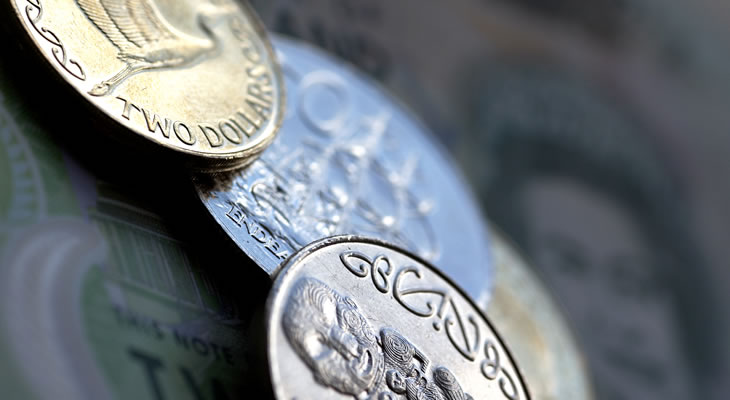UPDATE
The Pound Sterling to New Zealand Dollar (GBP/NZD) exchange rate dived by around -0.5% on Wednesday morning.
Although Bank of England (BoE) Governor Mark Carney suggested that the British economic recovery is not debt-fuelled, the Pound is holding a weak position versus most of its peers. The lack of demand for Sterling can be linked to speculation that the BoE will delay a rate hike until the end of 2016 thanks to low inflation and tepid wage growth. Meanwhile, the ‘Kiwi’ (NZD) advanced versus many of its rivals after market sentiment improved following positive Chinese data. China’s trade balance grew beyond expectations after imports contracted less-than-forecast.
The Pound Sterling to New Zealand Dollar (GBP/NZD) exchange rate is currently trending in the region of 2.1954.
Yesterday…
GBP/NZD Conversion Rate Predicted to Hold Losses after Industrial/Manufacturing Output Missed Estimates
The Pound Sterling to New Zealand Dollar (GBP/NZD) exchange rate softened by around -0.7% on Tuesday afternoon.
In response to less-than-ideal British data the Pound softened against all sixteen of its most traded currency rivals. Initiating the depreciation was December’s BRC Like-For-Like Sales which showed just 0.1% growth despite the market consensus of 0.5%. This disappointing result did have a silver lining, however, as the report showed improvement for Supermarket sales over the Christmas holiday…ending a long period of stunted supermarket sales.
David Potts, chief executive at Morrisons said: ‘We are pleased with our improved trading performance over the Christmas period. While there is of course much more to do, we are making important progress in improving all aspects of the shopping trip, and our customers tell us they are pleased with the changes. In addition, we have made further progress in debt reduction, and our financial position is strong and getting stronger.’
Also weighing heavily on demand for the Pound was less-than-ideal results from manufacturing and industrial production figures. November’s Industrial Production saw 0.9% growth on the year, well below the market consensus of 1.7%. Manufacturing Production in the same month contracted by -1.2% on the year which was well short of expectations of -0.8%.
Chris Williamson, chief economist at Markit, said: ‘Clearly, the industrial sector looks to have once again made no contribution to economic growth in the closing quarter of 2015, leaving the economy reliant on the services sector to sustain the upturn. Weakness in part reflects the struggling energy sector as the industry adjusts to lower oil prices and saw demand slump amid unseasonably warm weather.’
Williamson added: ‘However, manufacturers are also having a torrid time. Producers are having to deal with a toxic combination of a historically strong exchange rate, weak global demand, intensifying competition, notably from the US and continental Europe, as well as growing uncertainty about the outlook at home and abroad. None of these factors are like to disappear any time soon, leaving industry facing further hard times in 2016 and the economy worryingly unbalanced.’
The Pound Sterling to New Zealand Dollar (GBP/NZD) exchange rate is currently trending in the region of 2.2022.
NZD/GBP Conversion Rate Predicted to Hold Gains After Chinese Stocks Rose
Although market sentiment continues to err towards risk-aversion with global stock values dropping in response to weak oil prices, the New Zealand Dollar advanced versus some of its rivals. The appreciation is mostly the result of traders taking advantage of the comparatively low trade weighting, although improvement in December’s ANZ Commodity Price Index aided demand.
‘The ANZ commodity price index fell 1.8 percent month-over-month in December, but slower than November’s 5.6 percent decrease. Dairy prices dipped 3.5 percent in December, mainly due to the fall in prices of milk powder. Non-dairy prices also dropped 0.2 percent in December, the eighth consecutive monthly fall, with prices 17 percent below historic peaks. This was offset to some degree by higher forestry and aluminium prices. Meanwhile, seafood prices showed no variations,’ stated RTT News.
The Pound Sterling to New Zealand Dollar (GBP/NZD) exchange rate dropped to a low of 2.2014 during Tuesday’s European session.
Pound Sterling to New Zealand Dollar Forecast: Carney Speech to Provoke Volatility
Given the absence of further economic data pertaining to New Zealand during Tuesday’s European session, the ‘Kiwi’ (NZD) is likely to hold gains versus the Pound. With that being said, however, there is the potential for GBP/NZD volatility in response to a speech from Bank of England (BoE) Governor Mark Carney and the British NIESR Gross Domestic Product Estimate due for publication on Tuesday afternoon.
The Pond Sterling to New Zealand Dollar (GBP/NZD) exchange rate climbed to a high of 2.2271 during Tuesday’s European session.


Comments are closed.